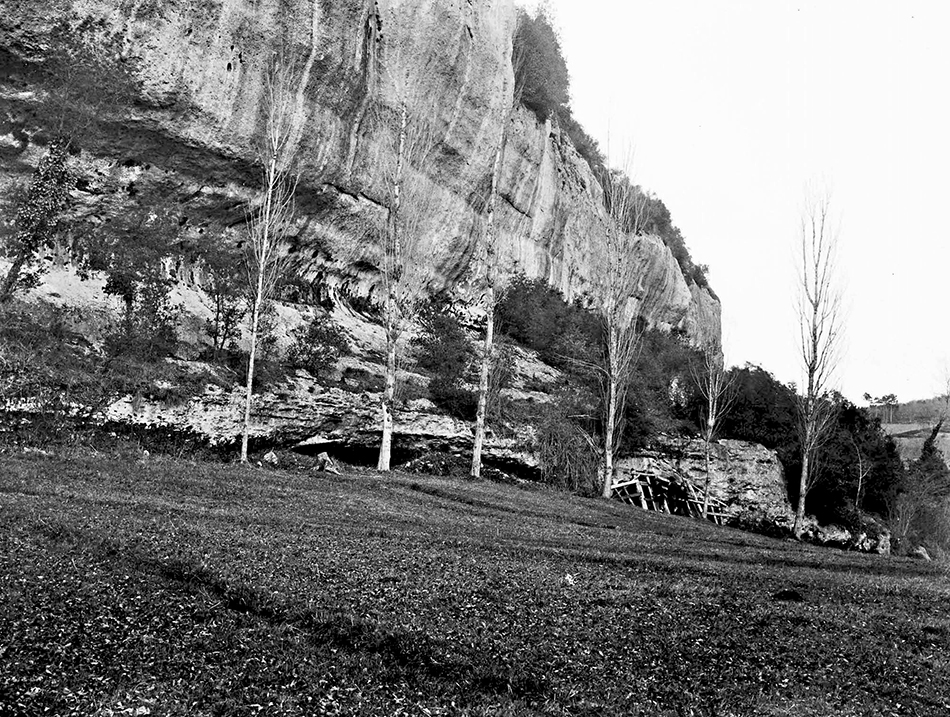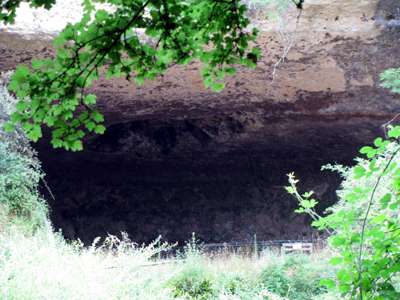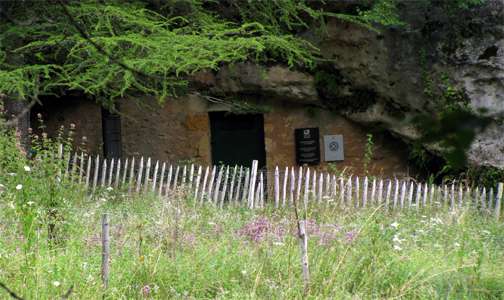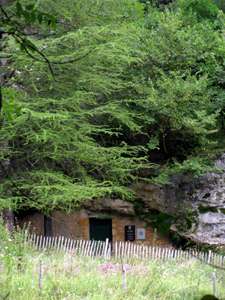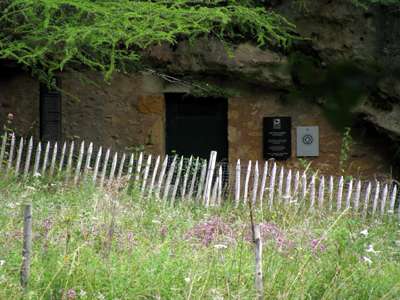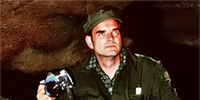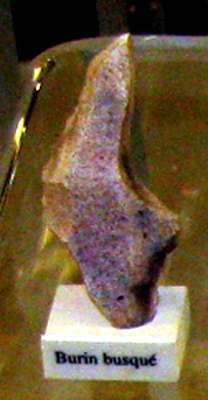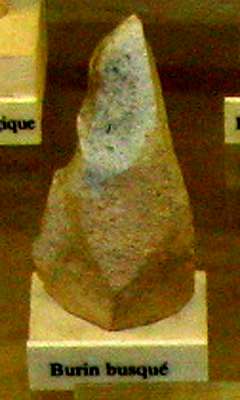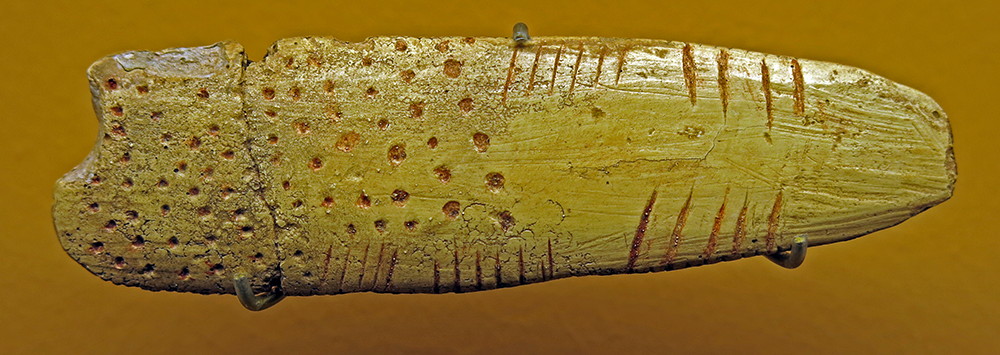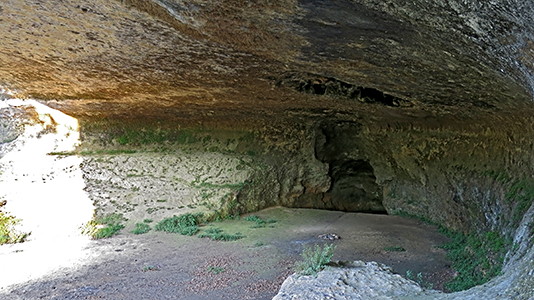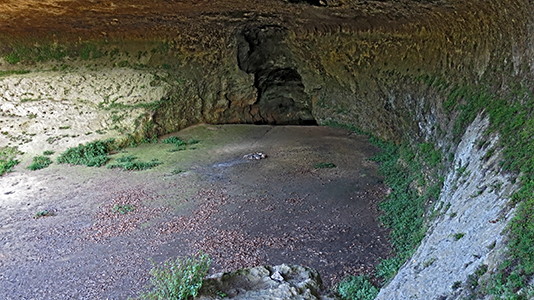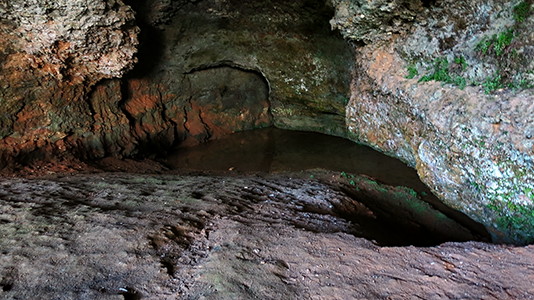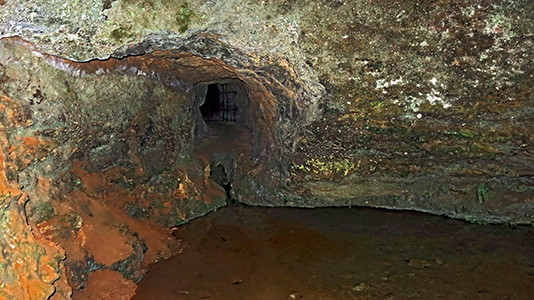Back to Don's Maps
 Back to Archaeological Sites
Back to Archaeological Sites
L'Abri Poisson and La Gorge d'Enfer
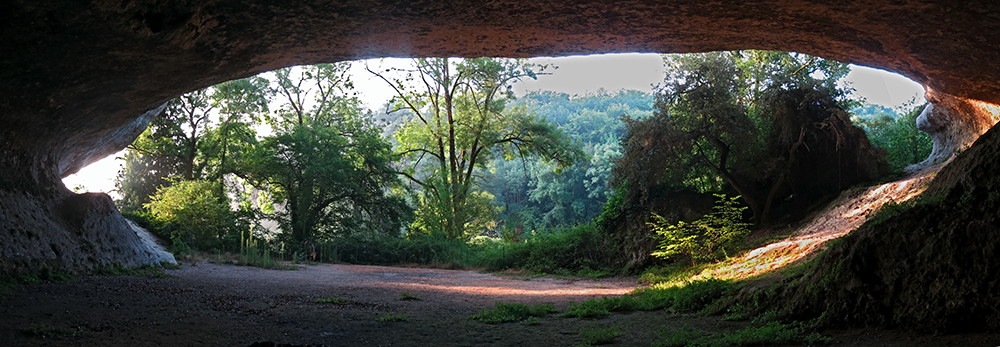
The most impressive cave or abri in the Gorge d'Enfer is this one, the Grand Abri.
It would certainly have been occupied in the Palaeolithic, but sadly the cave was excavated in the 19th Century for fertiliser.
Photo: Don Hitchcock 2014
Note that the curator and owner of the Gorge d'Enfer is Doctor Jacques Leclerc, f.leclerc@mac.com for further enquiries.
The site is private, so any visit or photo / videos and mention of the site are protected and should first get the approval of the owner before being published. It is also now a centre of confidential scientific researches.
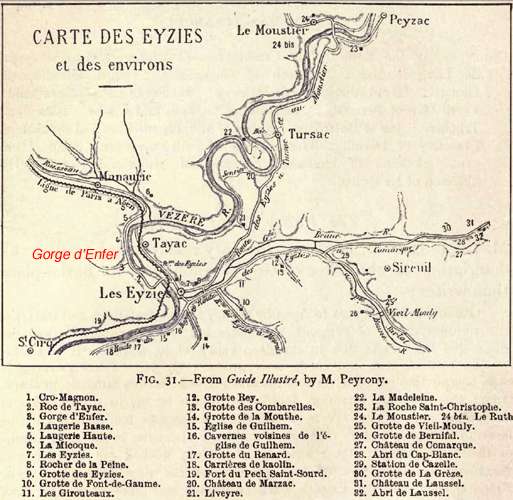
Map of the Les Eyzies area, showing, at number 3, La Gorge d'Enfer.
It is between the Roc de Tayac (Fort de Tayac) and the Grotte du Grand Roc, with Laugerie Basse a little further on.
Photo: Guide Illustré, by M. Peyrony published in Munro (1912)
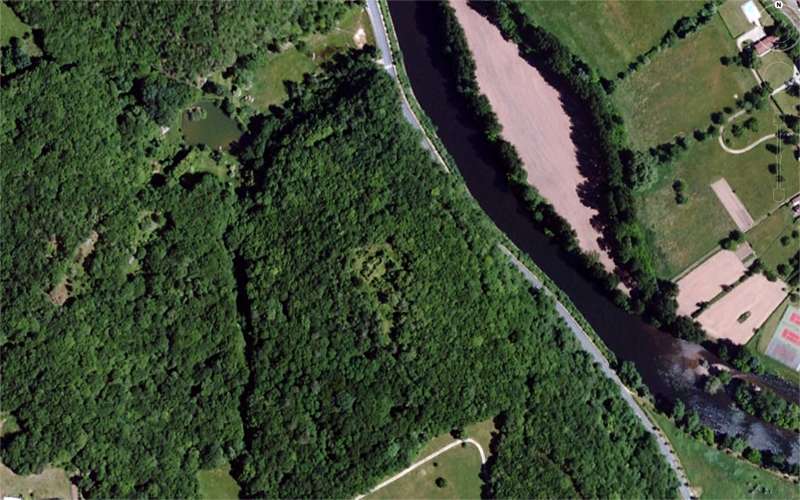
Google Earth image of the Gorge d'Enfer.
The gorge starts at the top of the photo, beside the road and the Vézère River, with the abris on the true left of the open area, that is on your left as you look from the open area of the little valley and creek towards the main road. The minor dirt road runs through the trees on the true right of the gorge, finishing in the farmer's field at the bottom left centre of the photograph.
It is part of the pedestrian tour shown at:
http://www.gpx-view.com/gpx.php?f=gorge_enfer_eyzies.gpx
Photo: Google Earth
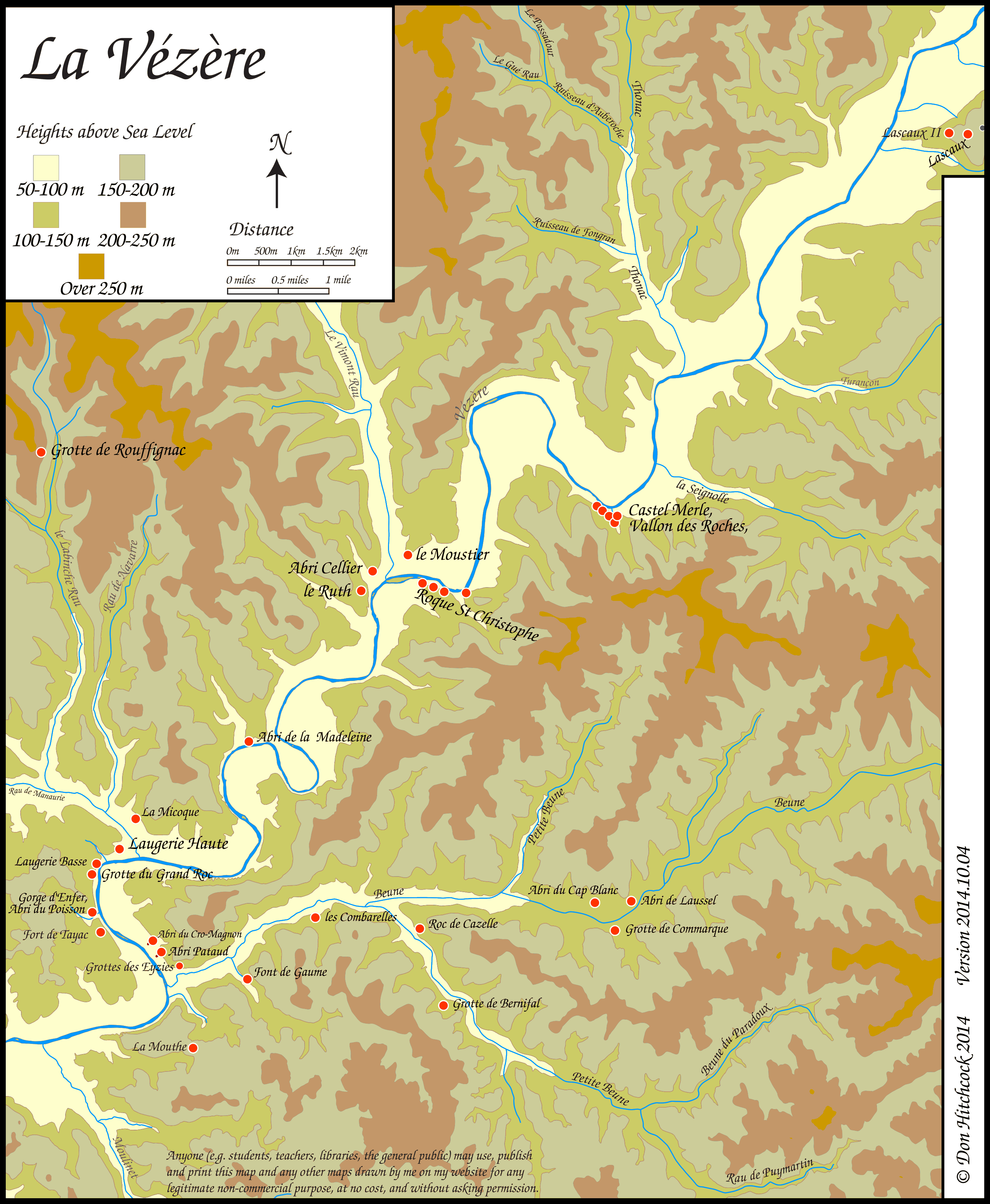
Map of sites in the Vézère Valley of France, including Gorge d'Enfer.
If you click on the map you will see a larger map with the ability to click on the marked sites and get further information.
Photo: Don Hitchcock
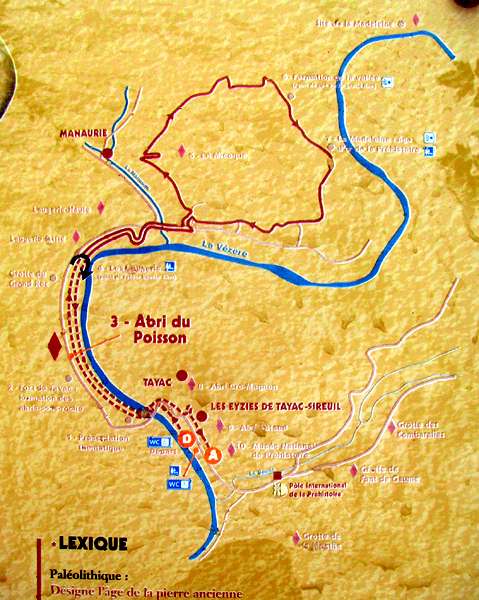
Map of the general area. L'Abri du Poisson is in the Gorge d'Enfer.
Photo: Don Hitchcock 2008
Source: Display on the footpath beside the main road which follows the Vézère River.
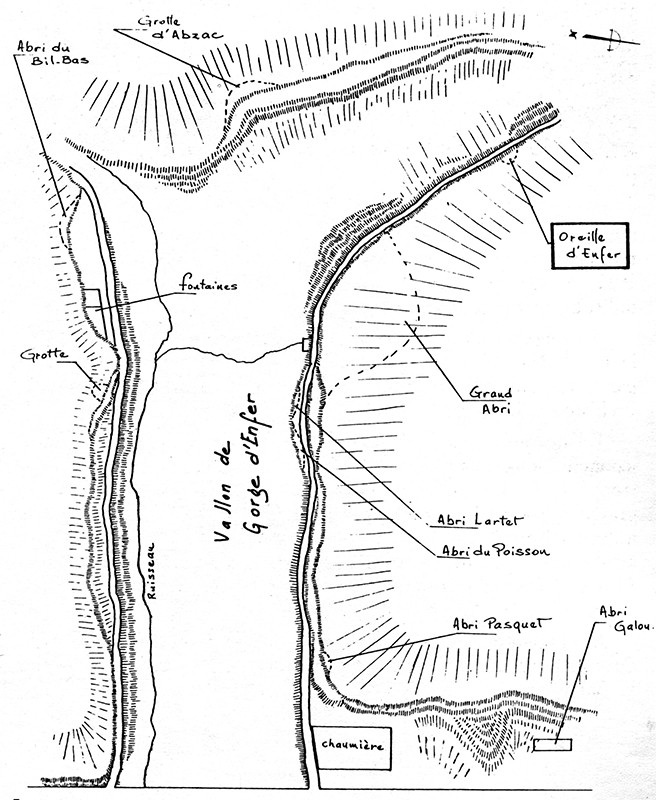
Map of the Gorge d'Enfer.
Photo: Leroi-Gourhan (1984)
The Gorge d’Enfer valley at the end of 1912. On the right we see the condemned entrance of le Poisson shelter, picture D. Peyrony.
Photo: D. Peyrony, 1912
Source: journals.openedition.org/paleo/4058?lang=fr
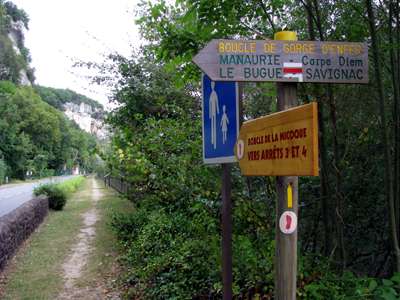
Sign to la Gorge d'Enfer from the main road.
Photo: Don Hitchcock 2008
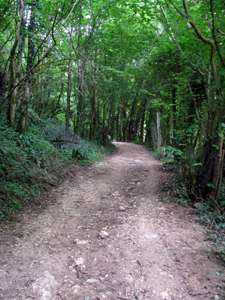
It is a very pleasant walk, on a well made dirt road, which is not very steep, but climbs continuously.
Photo: Don Hitchcock 2008
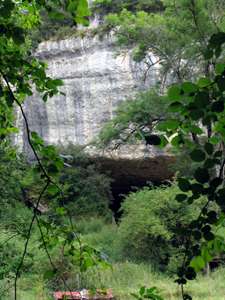
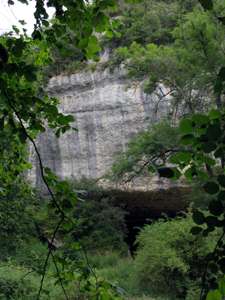
The road passes on the opposite side of the gorge to the long line of abris on the true left of the gorge. This is one of the abris.
Photo: Don Hitchcock 2008
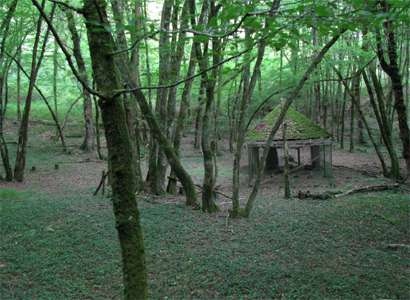
The little dry valley soon flattens out, and gives views such as this of old abandoned buildings and forests with open floors.
Photo: Don Hitchcock 2008
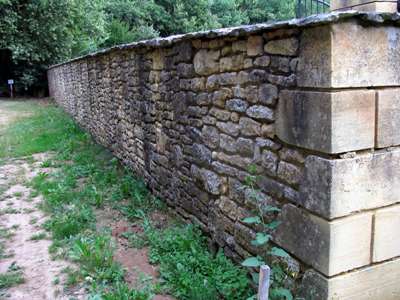
At the crest of the valley, I found this beautiful and very well constructed stone wall. Note the rubble used for the main part of the wall, the dressed stone at the ends, and the roof with an overhang which protects the wall from the weather. I am also a stone wall builder, and this was done by a master of his trade.
Photo: Don Hitchcock 2008
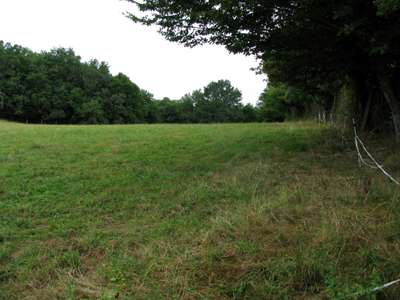
I had hoped for something more spectacular, but the road petered out into a farmer's field. Note the temporary and inoperative electric fence on the right. I retraced my steps.
Photo: Don Hitchcock 2008
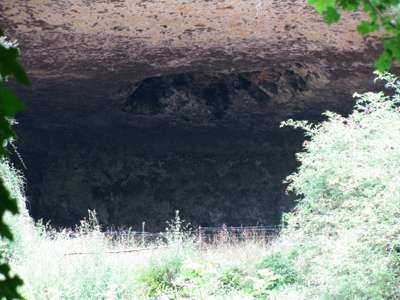
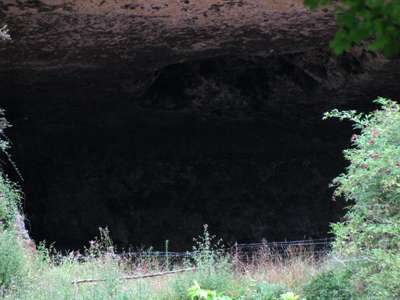
I zoomed in on the abris on the true left of the gorge from the road I was on. It would seem that there had been the opportunity for these to have been important archaeological sites.
This is the abri known as the 'Grand Abri'. It was, unfortunately, totally excavated for fertiliser, and there is no archeological information about it. This is a very sad state of affairs.
Photo: Don Hitchcock 2008
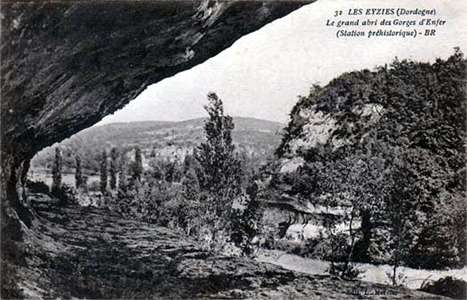
'Le Grand Abri' in an early postcard.
This is not actually of the main salle of the Grand Abri itself, but the continuation of it along the cliff line.
Photo: http://catherinearnoux.perso.neuf.fr/cpa/liscart/cpa24/24cpa/gdabri.htm
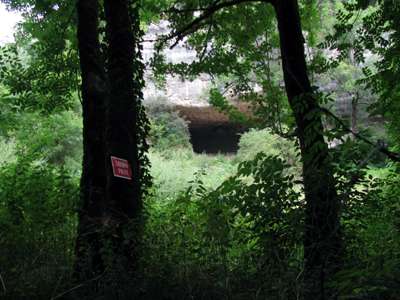
There was very swampy ground in the way to the abri. A small rivulet runs through the depression.
Photo: Don Hitchcock 2008
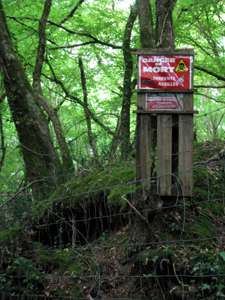
I laughed out loud when I came to this sign, advising trespassers that there were snakes and bees in the area which would kill you given half a chance!
Photo: Don Hitchcock 2008
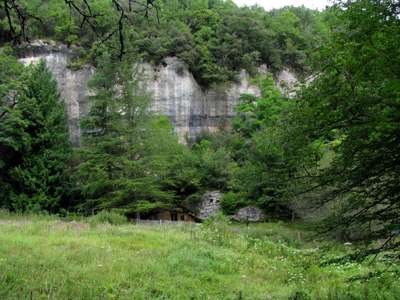
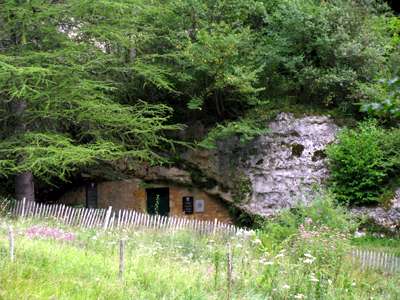
The Abri du Poisson was on the other side of the gorge. I made a trip to visit the Abri on another day, but photographs were not allowed inside the Abri.
Photo: Don Hitchcock 2008
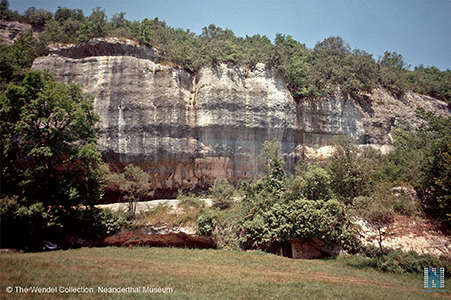
From a distance, we can see that the Abri du Poisson is backed by a large cliff.
Here we can see the stone wall and steel door of l'abri Poisson, the low abri Lartet, and above these the start of the Grand Abri, with the main chamber out of frame to the left of this photo.
Photo: Heinrich Wendel (© The Wendel Collection, Neanderthal Museum)
L'Abri Poisson
L'Abri Poisson is located in the valley of the Gorge d'Enfer, on the right bank of the Vézère River near Les Eyzies-de-Tayac.
The shelter was discovered in 1892 by Paul Girod, and dates from the Aurignacian. In 1912 Jean Marsan identified the fish carved in the ceiling of a small abri that made the site famous. 1.05 m long, it is etched and carved in low relief on the ceiling of the vault, enhanced with red pigment. This salmon's attitude is characteristic of a male exhausted by spawning. The theme is rare since only ten fish have been identified in the Paleolithic cave art.
The attribution of these works to the Gravettian (25 000 years BP) is probable.
The site narrowly escaped looting through the intervention of Denis Peyrony. Indeed, multiple holes have been drilled around the figure of fish for the release of a portion of the wall. The holes bordering the sculpture are still visible and show the attempted robbery.
Since 1979, the site is a World Heritage by UNESCO, in association with other sites and caves with the region under the name "sites and prehistoric painted caves in the valley of the Vezere. The site is still open to visitors.
Text: Translated and adapted by Don Hitchcock from http://fr.wikipedia.org/wiki/Abri_du_Poisson
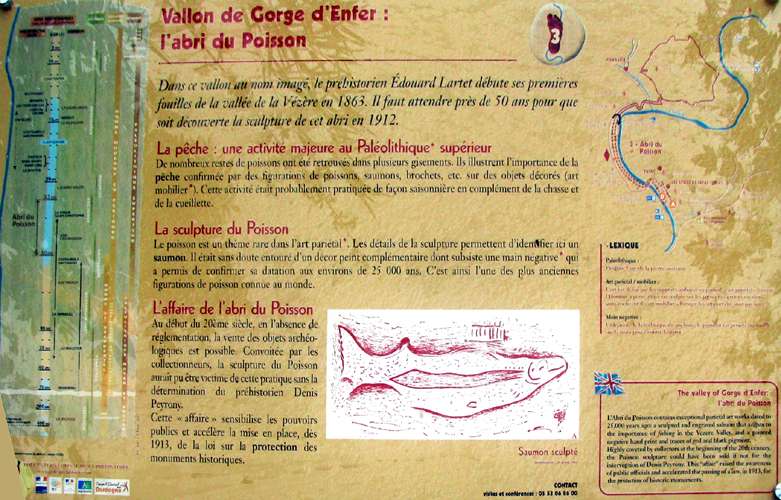
This information board on the main road had been well researched and presented.
Photo: Don Hitchcock 2008
Source: Display on the footpath beside the main road which follows the Vézère River.
In this valley, the prehistorian Édouard Lartet began the first excavations of the valley of the Vézère in 1863. Fifty years later, in 1912, the sculpture of a fish was discovered in the Abri du Poisson.
Fishing: A major activity during the upper Palaeolithic
Numerous remains of fish have been recovered in many nearby archaeological sites. They illustrate the importance of fishing confirmed by the representations of fish - salmon, pike, etc, on decorated objects. Fishing was probably done on a seasonal basis, as a complement to hunting and gathering.
The Fish Sculpture
The fish is a rare theme in parietal art (the art on cave walls). The details of the sculpture allow us to identify this one as a salmon. It was probably originally surrounded by a complementary painted décor of which now remains only a negative hand and traces of red and black pigments which confirmed this dating at around 25 000 years BP. Thus this is one of the oldest known representations of fish in the world.
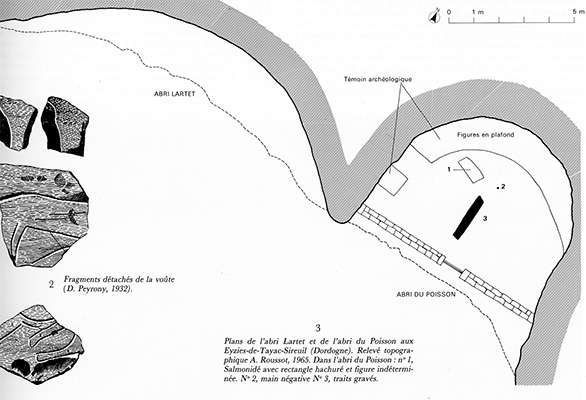
Plan of the Abri du Poisson
Photo: Heinrich Wendel (© The Wendel Collection, Neanderthal Museum)
Source: Leroi-Gourhan (1984)
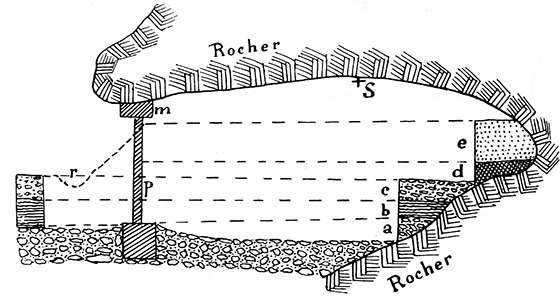
Profile of the Abri du Poisson from the excavation in 1917-1918.
Photo: Heinrich Wendel (© The Wendel Collection, Neanderthal Museum)
Source: Peyrony (1932)
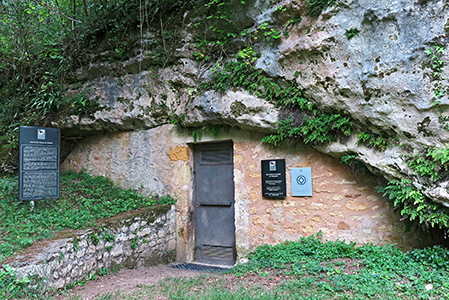
This is the entry to l'abri Poisson.
Photo: Don Hitchcock 2014
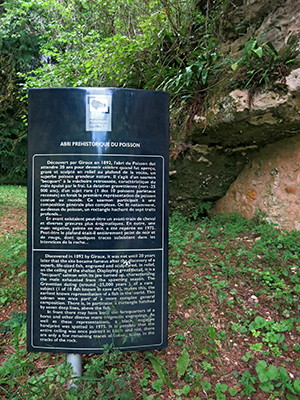
Sign outside l'abri Poisson.
Discovered in 1892 by Giraux, it was not until 20 years later that the site became famous after the discovery of a superb, life sized fish, engraved and sculptured in relief on the ceiling of the shelter. Displaying great detail, it is a 'Becquart' salmon with its jaw turned up, characterising the male exhausted from the spawning season. The Gravettian dating, circa 25 BP, of a rare subject (one of ten fish known in cave art) makes this, the earliest known representation of a fish in the world. This salmon was once part of a more complex general composition. There is, in particular, a rectangle hatched by seven deep lines above the fish.
In front there may have been the forequarters of a horse and other diverse, more enigmatic engravings. As well as these representations, a black, negative handprint was spotted in 1975. It is possible that the entire ceiling was once painted in black and red, there are only a few remaining traces of colour today, in the cracks of the rock of the ceiling.
Photo: Don Hitchcock 2014
Text: sign at the site
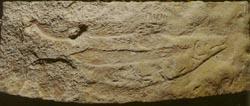 A metre long life size salmon, made on the overhang of Abri du Poisson in the Gorge d'Enfer is the only sculpted representation of a fish, an animal rarely depicted in cave art, although it appears more often in portable art.
A metre long life size salmon, made on the overhang of Abri du Poisson in the Gorge d'Enfer is the only sculpted representation of a fish, an animal rarely depicted in cave art, although it appears more often in portable art.
There was an attempt made once to steal this sculpture, and the thieves were disturbed at the point where they had put a series of holes around the sculpture ready to undercut it. This photo is probably of a well made cast of the original, since it appears to be free standing. Sharon Rogers tells me the original is still in place, on the ceiling of a small cave just south of Laugerie Haute.
Photo: 'Discovering Perigord Prehistory' by B & G Delluc, A Roussot & J Roussot-Larroque.
My thanks to Sharon Rogers/walkhound who alerted me to the existence of this excellent book.
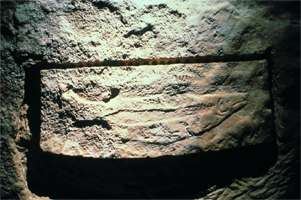
This photograph of the carving in situ shows the drill holes and carving which was done preparatory to the attempted removal of the engraving.
When I visited the cave, it seemed to me that the thieves would have tried to crack the block off the ceiling by chiselling from the lower part of the carving, since there had been a lot of work done to gain access to that part of the sculpture.
There would have been a significant risk of destroying the carving completely if the work had proceeded any further.
Photo: eptb.asso.fr
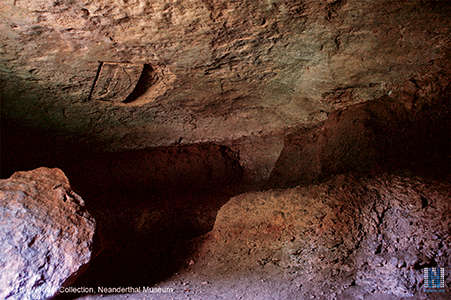
Abri du Poisson ceiling, showing the salmon.
Photo: Heinrich Wendel (© The Wendel Collection, Neanderthal Museum)
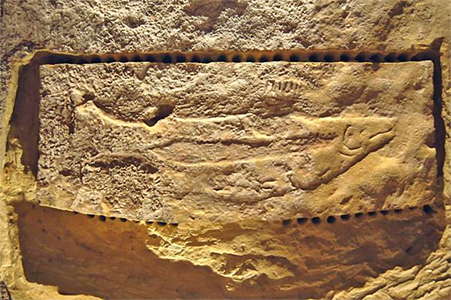
This is a good photograph to show the drilling and chiselling that went on during the attempt to steal the sculpture.
Photo: http://www.tourisme-vezere.com/fr/fiche/Grotte-et-gouffre-Dordogne-Perigord/Abri-du-Poisson/PCUAQU024FS0000O
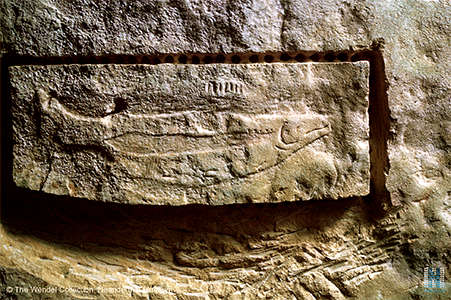
Abri du Poisson salmon closeup.
Photo: Heinrich Wendel (© The Wendel Collection, Neanderthal Museum)
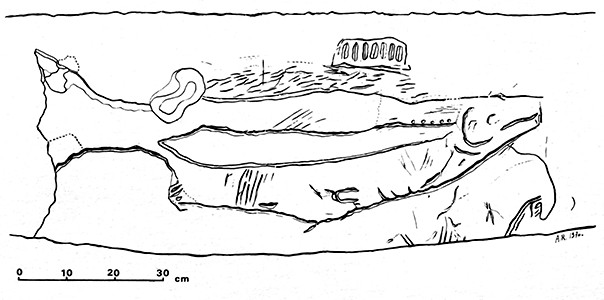
Abri du Poisson salmon, 105 cm long.
Photo: A. Roussot
Source: Leroi-Gourhan (1984), 155
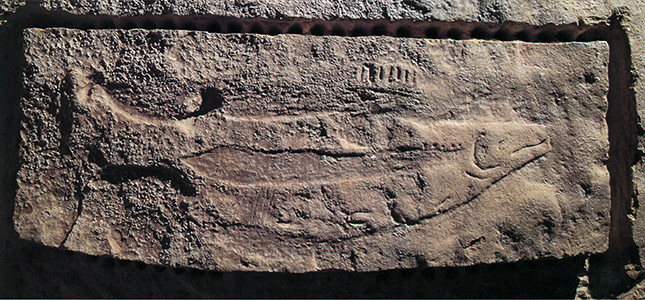
Abri du Poisson salmon.
Photo: A. Roussot
Source and text: Leroi-Gourhan (1984)
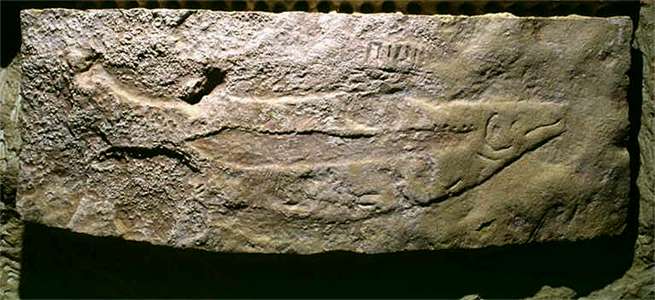
Another image of the salmon.
Photo: http://www.culture.gouv.fr/
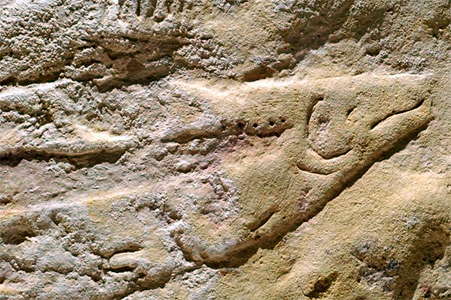
This is a closeup of the head of the fish. Note the calcite deposits on the sculpture.
Photo: http://www.tourisme-vezere.com/fr/fiche/Grotte-et-gouffre-Dordogne-Perigord/Abri-du-Poisson/PCUAQU024FS0000O
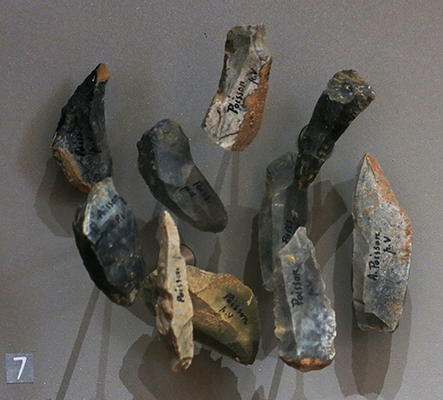
Microwear analysis of these flint tools found on the floor of the abri has shown that they were used for engraving and were probably used to carve the fish on the ceiling - a lot of tools would have been blunted in the process of carving such a large engraving.
Photo: Don Hitchcock 2014
Source: Originals on display at Le Musée National de Préhistoire, Les Eyzies-de-Tayac
The Abri du Poisson Affair
At the start of the 20th century, in the absence of regulation, the sale of archaeological objects was possible. Coveted by collectors, this sculpture of a fish was very nearly the victim of this practice, averted by the determination of the prehistorian Denis Peyrony.
This case alerted the government to the problem, and accelerated the development of the 1913 law on protection of historical monuments.
Text: Translated from the display on the footpath beside the main road which follows the Vézère River.
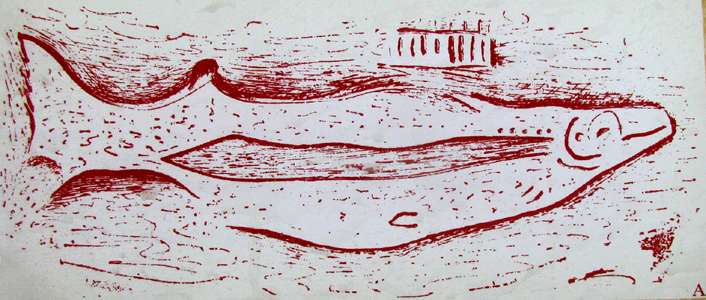
Close up of the drawing of the fish sculpture in the roof of the cave.
Photo: Don Hitchcock 2008
Source: Display on the footpath beside the main road which follows the Vézère River.
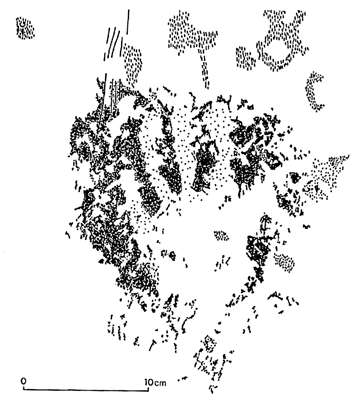
Tracing of the negative black stencil of a hand on the roof of the small shelter of Abri du Poisson.
Photo: © B. and G. Delluc 1991
Source: Jaubert (2008)
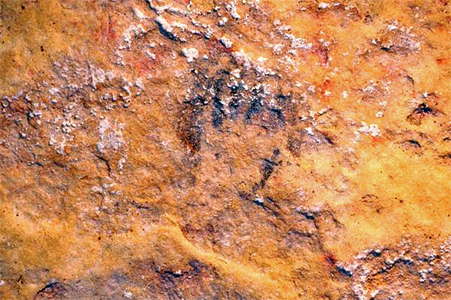
The hand appears not to have been created by the normal spitting or blowing or 'airbrush' technique using a bowl of ochre and a hollow reed, but by outlining the hand with a brush of some kind.
Photo: http://www.tourisme-vezere.com/fr/fiche/Grotte-et-gouffre-Dordogne-Perigord/Abri-du-Poisson/PCUAQU024FS0000O
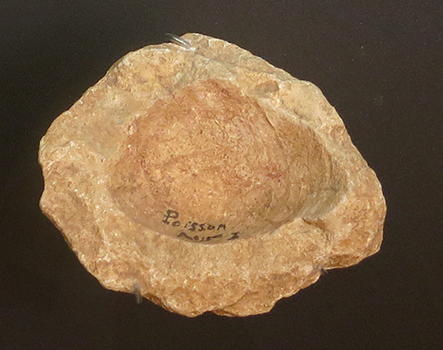
Godet from l'abri du Poisson, used for grinding ochres for painting.
Photo: Don Hitchcock 2014
Source: Original on display at Le Musée National de Préhistoire, Les Eyzies-de-Tayac
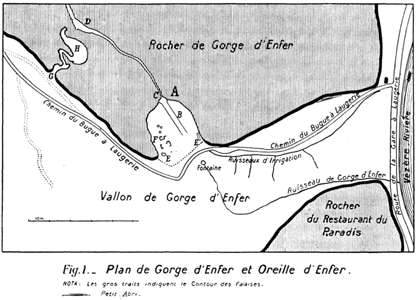
Plan of the Gorge d'Enfer and the Oreille d'Enfer.
Photo: Giraux et al (1907)

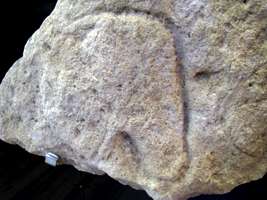
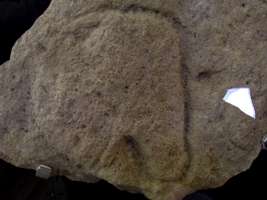
Abri Poisson, Perigordian engraving of a vulva.
Photo: Don Hitchcock 2008
Source: Original, display at Musée National de Préhistoire, Les Eyzies
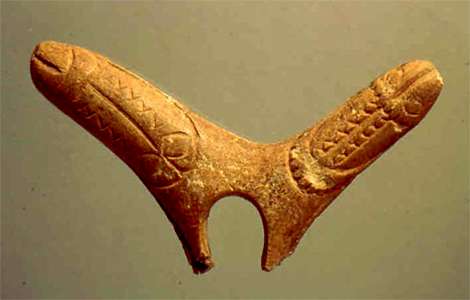
Gorge d'Enfer, double phallus. This appears to be part of a broken Baton Percé.
Note that some think that this may be a modern fabrication.
Photo: http://www.hominides.com/html/references/sexe-prehistoire-paleolithique-art2.php
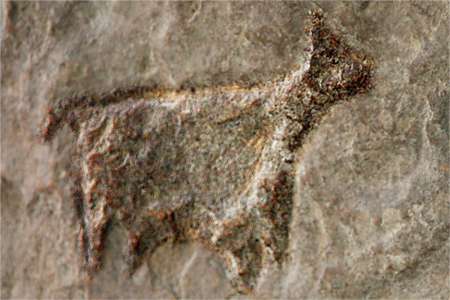
Unidentified quadruped (most probably an herbivore) found in the cave of Oreille d'Enfer ("ear of Hell"), in Les Eyzies-de-Tayac, Dordogne, France. Aurignacian culture. It can be viewed in the National Prehistory Museum in Les Eyzies-de-Tayac.
Date: 25 September 2009(2009-09-25)
Source: Own work
Author: Sémhur
Permission: Creative Commons Attribution-Share Alike 3.0 Unported, 2.5 Generic, 2.0 Generic and 1.0 Generic license.
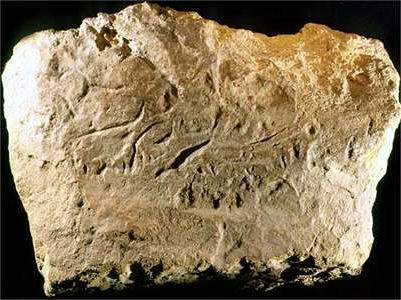
Decorated block from the Oreille d'Enfer, showing two small herbivores.
Length 108 cm, width 77 cm, thickness 38 cm.
The Cave of the Oreille d'Enfer, a classified historical monument, opens from the valley of the Gorge d'Enfer in Eyzies-de-Tayac. Explored in 1864, it became famous mainly because of the decoration on the walls attributed to the recent Perigordian, discovered in 1922. The principal motif, detached from the wall in 1960, for reasons of conservation, is composed of two small herbivores, without horns or antlers, perhaps superimposed according to Breuil as a large animal, possibly a rhinoceros.
This scene was part of a larger whole which remains on site: the rock bench includes six series of cupules, groups of three or five around a central larger cavity, evoking an impression of a large carnivore.
Source: http://www.musee-prehistoire-eyzies.fr/pages/page_id19281_u1l2.htm (flipped left to right)
Photo: © Musée national de Préhistoire - RMN

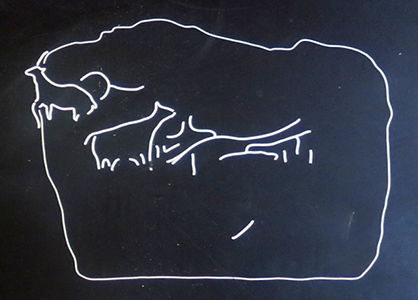
Quadrupeds and signs.
Oreille d'Enfer, Les Eyzies-de-Tayac, Dordogne.
Aurignacian or Perigordian.
Photo: Don Hitchcock 2014
Source: Original on display at Le Musée National de Préhistoire, Les Eyzies-de-Tayac
L'abri Lartet
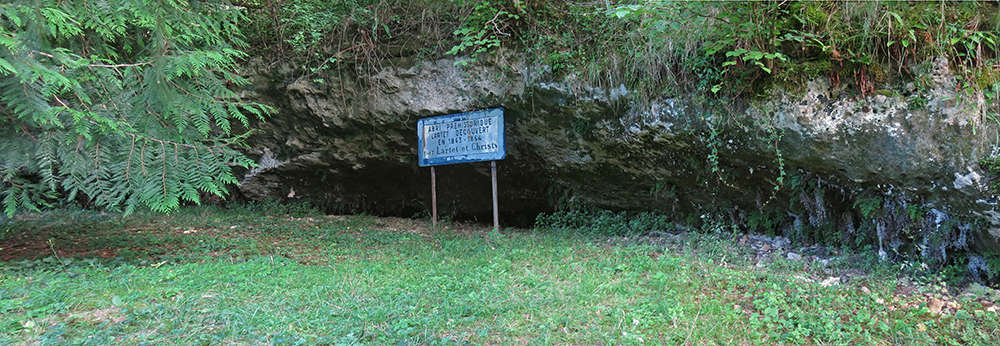
l'abri Lartet, Gorge d'Enfer, upstream twenty metres from l'abri du Poisson.
Photo: Don Hitchcock 2014
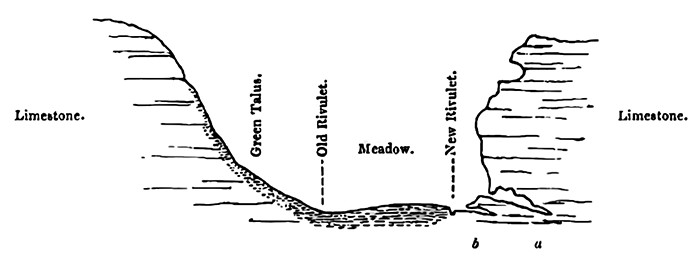
Diagram of the profile of the Gorge d'Enfer, a lateral valley on the right bank of the Vezère.
(a) Cave, with bones etc.
(b) Recess, with bones etc.
( this appears to be the only profile extant of l'abri Lartet - Don )
Photo and text: Lartet and Christy (1875)

Decorated bone pin from Abri Lartet in the Gorge d'Enfer, Dordogne, France.
Early Aurignacian period, about 34 000 years old
Deliberately made jewellery is unknown in Old Stone Age sites in Europe before the start of the Upper Palaeolithic. Some of the oldest known pieces came from the Abri Lartet, a shelter formed by a rock overhang where the users of distinctive split-based spear points camped during the early Aurignacian period, which in France lasted from 35 000 to 29 000 years ago.

This decorated pin, 20 cm long, is a rare piece. There is nothing to compare with it in the whole of western Europe. From the flattened tip the smooth shaft becomes more rounded towards the middle where the simple notched decoration starts. This extends all round the shaft onto the head which is in part still rough and may not have been finished. The tip is thin and flattened. It appears unsuitable for use as a tool. On a person, it might have been worn in the hair or, to hold the sides of a collar or jacket front together below the shoulder.
Perforated bone pendants with notched decoration and waste from making ivory beads were also found at the site.
Text: A. Sieveking, A catalogue of Palaeolithic art (London, The British Museum Press, 1987)
Source: http://www.britishmuseum.org
Both photos: © The British Museum
Other Data:
Length: 20 cm
Bequeathed by Henry Christy (1864)
Sieveking Catalogue no. 151 (Christy Collection slip number 51)
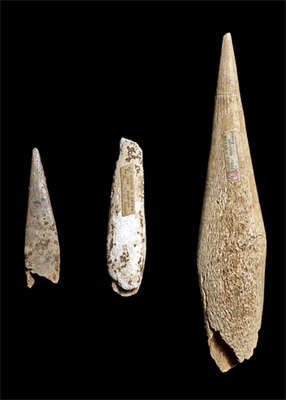
Split-based spear points
Early Aurignacian, about 35 000 BP
From the abri Lartet in the Gorge d'Enfer, Dordogne, France
These points are made of antler and are split at the base by the removal of a wedge-shaped fragment. The thinned end of a wooden spear shaft could be pushed into the slot and the join fixed with string made from animal hair, gut or muscle fibres. Although they vary in size, split-based points generally widen above the base then narrow to the tip, forming a lozenge shape with a rather flat cross-section. Notched decoration on the edges is rare.
Split-based points are characteristic of the earliest phase of the late Old Stone Age or Upper Palaeolithic known as the Aurignacian. Appearing about 40 000 years ago, they are the first distinctive spear tips to be made from bone antler and ivory and show the use of composite weapons made of more than one piece. In use for about ten thousand years, they were replaced later in the Aurignacian by rod-like spear tips with round and oval cross-sections, thinned or bevelled to fit the shaft.
Length 12 cm
Photo: © The British Museum
Excavated and bequeathed by Henry Christy
P&EE Christy Collection. Slip numbers 339, 340, 341
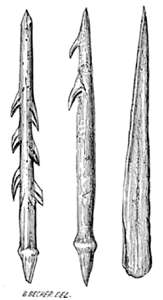
The two objects on the left are bone points, apparently harpoons, and the one on the right is an awl, all three of which are from the Gorge d'Enfer, from the collection of Broca.
Photo: Dawkins (1874)
Note on the Aurignacian of l'Abri Pasquet at Gorge d'Enfer, Les Eyzies, Dordogne.
Translation: Don Hitchcock
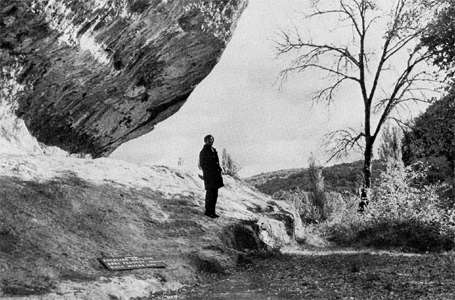
Labelled as L'Abri Lartet by Sieveking, this is actually L'abri Pasquet, as may be seen from the sign at the base of the abri, just below the stairs cut in the slope during medieval times, when it was inhabited again.
Photo: Sieveking (1979)
L'abri Pasquet occupies a rocky terrace at the entry on the right side of the valley of the Gorge d'Enfer, above the abris of Lartet and Poisson.
This vast shelter is 15 metres long by 3 metres in depth, and was discovered and excavated by G. Peyrille. D. Peyrony subsequently studied it, Peyrony (1906) and it is a site containing some traces of the Aurignacian Solutrean Peyrony (1906b).
The reddish-brown archaeological layer was at a depth of 50 cm, it was in the middle of the shelter and became very poor towards the cliff and towards the valley. Archaeologically this site was not very large.
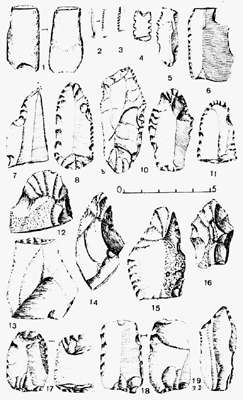
De Sonneville-Bordes (1960) drew up an inventory of 56 tools kept in the Musée des Eyzies and concluded that despite the absence of spears with split bases it is almost certainly Aurignacian I. In 1907 we have reviewed some of the best from all figures here shown, and have found some pieces formerly neglected and that present some interest now.
The tools shown here are from l'Abri Pasquet, Gorge d'Enfer, Les Eyzies (Dordogne), Aurignacian I.
Drawings by the author, Daniel Raoul.
Artwork, photo and text: Raoul (1970)
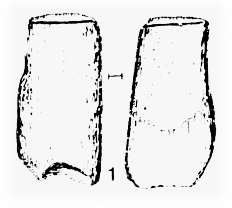
1) is the base of a broken languette or tongue. In this case the waste is important because it indicates that this type of spear existed at l'Abri Pasquet.
Photo and text: Raoul (1970)

2) is a lamelle Dufour (Dufour blade) with reverse retouch.
De Sonneville-Bordes(1960) lists two other tools of the same type from the material dug from l'Abri Lartet, undoubtedly belonging to the Aurignacian.
Photo and text: Raoul (1970)
The lamelle Dufour is, by definition, a blade, much smaller than the fléchette or dart point (a dart is a light spear thrown with a spear thrower or atlatl). But it is essentially the morphological characters and technology that separates them. The often curved shape of the lamelle Dufour is opposed to the straightness of the fléchette.
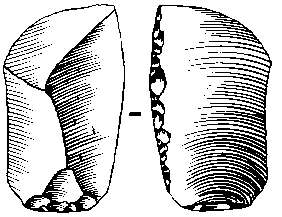
Inverse retouch
Inverse retouch position is the opposite of direct retouch position in that it is formed "when removals start from the dorsal surface" (Tixier 1974). It is more difficult to apply than direct retouch in that the knapper must work from a convex surface on to a flat surface. No traces of it can not be seen from the dorsal face - it is only visible from the ventral surface.
Photo and text: http://www.hf.uio.no/iakh/forskning/sarc/iakh/lithic/retouchposition.html
Other objects shown are:
![]()
3) Blade with blunted back.
Photo and text: Raoul (1970)

4) A fragment of a slate pendant, decorated with two rows of notches.
Photo and text: Raoul (1970)

5) Serrated/denticulate blade.
Photo and text: Raoul (1970)
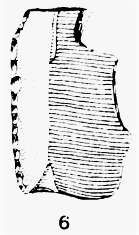
6) Burin sur cassure - a burin with a bevel formed at the intersection of a break and the edge of a flake. The working edge is the edge of the broken part.
Photo and text: Raoul (1970)
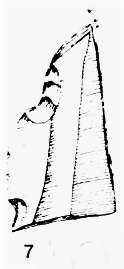
7) Burin busqué - A characteristic Middle Aurignacian tool, the beaked chisel or burin. It is a solid, heavily constructed tool whose bevel is formed by a large reduction of diameter from a large base to a relatively small point.
Photo and text: Raoul (1970)
Burins are relatively abundant for the Aurignacian (20.56%) and they almost all belong to the family of dihedral burins or chisels, the series has only one burin with oblique truncation. The most interesting group is made up of small tools ( Lacorre (1960), plate IV), which represent a transitional form between the dihedral angle burin and the beaked burin.
(The beaked burin is especially common in the Middle Aurignacian. In appearance it rather resembles the prow of a ship turned upside down; the working edge is convex, being formed by a flat graver facet on one side, and a series of convex graver facets up the prow; this produces a keeled scraper made on the breadth of a blade. There are two sub-varieties, one with a notch to prevent the little convex graver facets from going too far down the blade, and the other without.) Burkitt (1925)
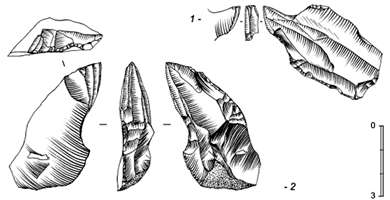
Burin busqué - the Beaked Burin
Figure 6 - Burin busqué, n°1 : Abri 2, couche 2, et burin busqué à tendance Vachons, n°2 : Abri 1, couche 2 (dessins D. Pesesse).
Figure 6 - Burin busqué, n°1 : shelter 2, layer 2 and burin busqué near of the Vachon’s type, n°2 : shelter 1, layer 2 (drawings D. Pesesse).
Photo and text: http://paleo.revues.org/index184.html
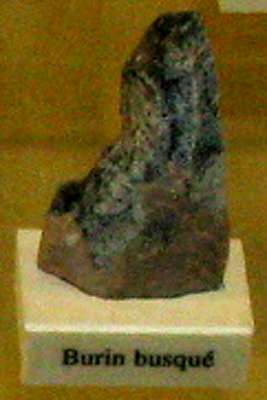
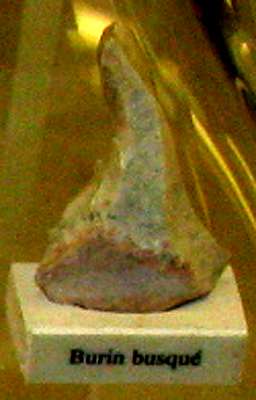
Un outil caractéristique de l'Aurignacien moyen - le burin busqué. C'est un outil robuste dont le biseau est formé par la rencontre d'un enlèvement lamellaire assez large et de plusieurs enlèvements contigus parfois incurvés et arrêtés par une encoche.
A characteristic Middle Aurignacian tool - the beaked chisel or burin.
It is a solid, heavily constructed tool whose bevel is formed by a large reduction of diameter from a large base to a relatively small point.
Photo: Don Hitchcock 2008
Source: Display at Abri Pataud Museum. These appeared to be originals.

Burin busqué - the Beaked Burin
Three or more fairly regular spalls, often removed from a Spall Removal Surface (SRS) of dihedral type, approximate a semicircle. An edge of this shape is sometimes described as the "gouge" or "busqué" type.
(This is an excellent diagram of what I think of as a "classic" beaked burin, as described by Burkitt (1925) above. Note the front vertical spall, and the notch taken out of the rear of the burin to make sharpening easier, so that a spall comes off easily when retouching. - Don)
Photo and text: Movius et al (1968)
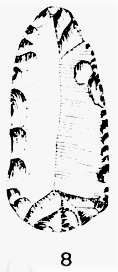
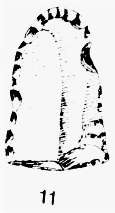
8) and 11)
Grattoir lamelle, scraper blade, Aurignacian.
Photo and text: Raoul (1970)
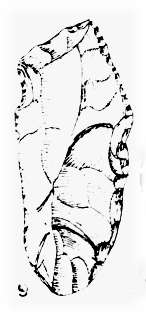
9) Racloir sur lame à troncature oblique - scraper on a blade, with oblique truncation.
Photo and text: Raoul (1970)

12) caréné épais - thick, keeled scraper.
Photo and text: Raoul (1970)
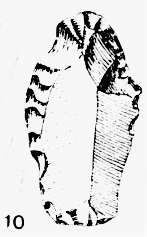

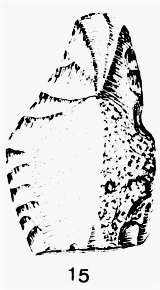
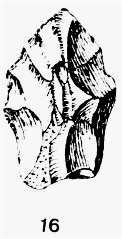
10), 14), 15), 16) grattoirs à museau are known in English as muzzle shaped scrapers, or "nose" scrapers.
Photo and text: Raoul (1970)
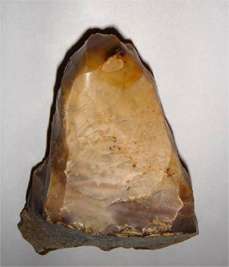
This is an illustration, for reference and explanation, from another site, of a particularly good Grattoir à museau, or muzzle shaped scraper.
Photo: http://che70.blog4ever.com/blog/lesphotos-13327-8270.html
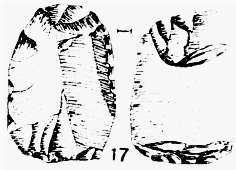
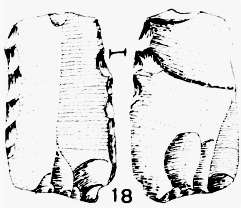
17), 18), pièces esquillées , splintered pieces, (we have three), they are frequent in regions with poor flint, as in the vicinity of Brive, and are not common in the Perigord.
Photo and text: Raoul (1970)
Pièces Esquillées
The physical aspects of a pièce esquillée are: battered, straight working edge, with overlapping, step-like, horizontal fractures; a thin, concave upper edge, with flutes, showing prominent wave lines, representing the end being struck during use; and the overall thick, wedge like shape. This type of lithic tool is described as having been used as a wedge for splitting bone.
One method for producing the thick flakes used in this process is described as bipolar, employing direct hard percussion against one end of a core or nodule, with the opposite end resting on a stone anvil. However any suitable thick flake was occasionally used, including small, expended/waste cores.
Text above from Wesley (1974)
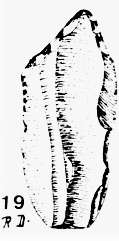
19) blade with oblique truncation.
Photo and text: Raoul (1970)
Other flints collected are common types. There were three shells (gastropods) and a pebble bearing an artificial cupule.
For the sake of completeness, we mention the occurrence of human debris of uncertain age, as well as of pottery.
In summary the identity of the Aurignacian industries of the Abris Lartet, Poisson and Pasquet seems obvious.
From: http://www.guyenne.fr/Publications/Gourgues/Gourgues_part1.htm
Cave bear and Hyena teeth have been found at Gorge d'Enfer.
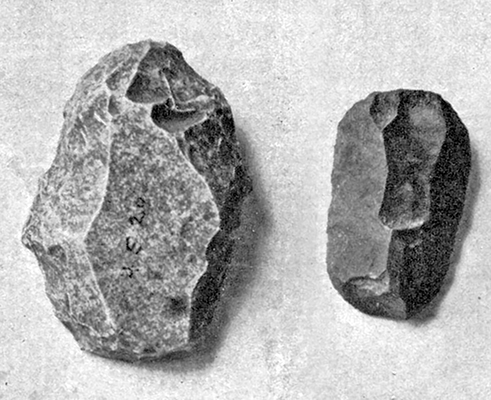
Oval scrapers from Gorge d'Enfer.
( no further details as to precise location are given - Don )
Photo and text: Collie (1928)
Stone Implements
A. Plate IX.
Two large, simple, untrimmed flakes of flint, from the Gorge d'Enfer, are here shown, such as are not uncommon in the Caves, having been used for cutting and scraping, without any other preparation than having, perhaps, one edge set in a piece of wood or antler for a handle or support. These almost
strigil-shaped ( a strigil is an instrument with a curved blade used, especially by ancient Greeks and Romans, to scrape sweat and dirt from the skin in a hot-air bath or after exercise; a scraper. - Don ) flakes have been struck off blocks of flint with one blow.
The upper ends shown here were uppermost during the process of flaking. The bulbs of percussion are slight, and not visible in the figures.
( The glazing referred to below is a common post-depositional alteration of the surface of a flint artefact. When present, the entire surface is usually uniformly affected. Almost all flint artefacts which have been exposed to ground water for extended periods of time exhibit some amount of glazing. This may be caused by adsorption of dissolved silica from soil solutions bathing the artefact in situ, or the dissolution and reprecipitation of siliceous constituents of the artefact's surfaces. Artefacts with advanced glazing (or gloss patina) have a true glossy lustre and feel pleasantly smooth to the touch.
See Howard (2002) for further explication of glazing - Don )
Fig. 1. A long curved flake of opaque, yellowish, granular flint, somewhat glazed.
The edges are irregularly chipped ; but some parts, especially on the left-hand side of the figure, have been worn by use.
Fig. 1a shows the ridge face, and fig. 1b the edge view of the flake.
Length 174 mm, breadth 38 mm, thickness 10 mm.
Fig. 2. A long curved flake of dark-grey granular flint, similar in general character to fig. 1. The straight portion of the left-hand edge in the figure is sharp and finely jagged, and has probably been used. As an implement, this flake could be conveniently held in the hand by the lower curved portion, and
the straight edge used for cutting or scraping.
Fig. 2a shows the ridge face, and fig. 2b the edge view of the flake.
Length 185 mm, breadth 41 mm, thickness 12 mm.
Source and text: Lartet and Christy (1875)
Proximal source: archive.org
Additional text: Wikipedia
The Lartet Bone
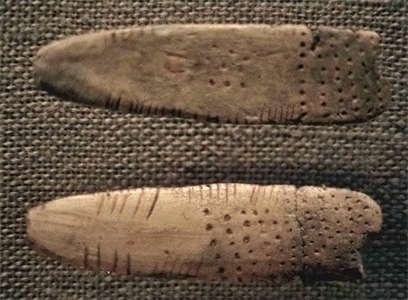
The Lartet bone, shown here, was unearthed at the Gorge d’Enfer in the Vézère Valley in Southern France in 1865.
In a crowded museum, the Blanchard and the Lartet bones would be easy to miss. Both are small, about ten or eleven centimetres in length, easily fitting into the palm of the hand. Both are heavily worked, presenting a flattened surface covered with "a seemingly chaotic, haphazard pitting." And so were these artefacts seen for many years: in general, they were interpreted as a "perfect example of non-notational random marking," as symptoms of "man’s urge to 'decorate', or to his 'need to fill an empty space', or to doodle in rare moments of leisure." For archaeologists and art historians, the stunning representational cave paintings from the same period and region held much more interest.
For nearly a century no one attempted a thorough analysis of the Lartet bone, even as other similar examples (eventually hundreds of them) turned up. In 1870, its discoverers, the retired French magistrate, Edouard Lartet, and the English businessman, Henry Christy, had determined it to be "puzzling," perhaps without any meaning at all, and deposited it in a museum.
Eventually, the Lartet bone found its way to the imposing Musée des Antiquités Nationales in Saint-Germain-en-Laye near Paris, where it was eventually to be joined by the equally perplexing Blanchard calendar bone. And there it would sit, in a scholarly midden, abandoned to a rarely-opened cabinet in a "musty … stone chamber" among "accumulations of Upper Palaeolithic materials, crowded under glass with their aged yellowing labels."
One hundred years later, Lartet’s description was still state-of-the-art.
Photo and text: http://mathed.byu.edu/~williams/Classes/300W2012/PDFs/PPTs/Beginnings%20of%20Counting%20and%20Numbers.pdf
Aurignacian of l'abri Lartet aux Eyzies-de-Tayac, Dordogne
Os gravé et encoché (moulage), engraved and notched bone.
This was discovered in 1865.
Photo: Don Hitchcock 2015
Source: Facsimile, Musée d'Archeologie Nationale et Domaine, St-Germain-en-Laye
Passages in the Grand Abri and the Oreille d'Enfer
We have the honor to convey to our colleagues of the Prehistoric Society of France, at the meeting of January 24, 1907, of the interesting discovery which has been made by M. Albert Massias, owner of the huge rock containing l'abri de Gorge d'Enfer, near Les Eyzies.
Responding to his invitation, we went, last Feb. 2nd, to Les Eyzies, and we were able to visit the very important work done by him.

Fig. 1
Plan of the Gorge d'Enfer showing the Grand Abri (ABCDEE') and the Oreille d'Enfer (GH).
Photo:
Giraux et al (1907)
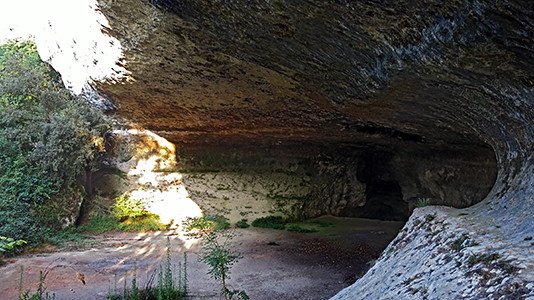
Entrance to le Grand Abri from the Gorge d'Enfer. .
Photo and text: Don Hitchcock 2014
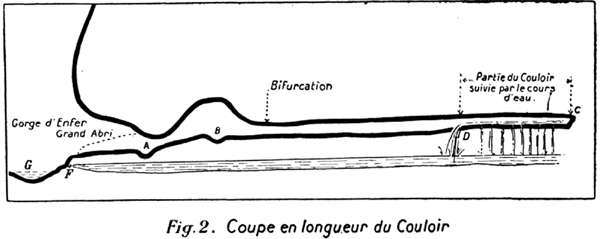
Fig. 2
Longitudinal section of the passage at the base of the Grand Abri.
Photo:
Giraux et al (1907)
Main room of le Grand Abri.
The floor was scraped flat when the contents were removed for fertiliser.
Photo and text: Don Hitchcock 2014
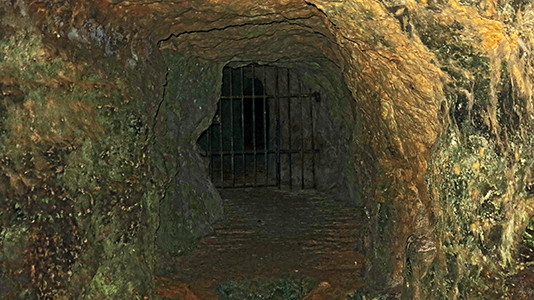
At the rear of the main room of le Grand Abri.
Here there is a shallow pool of water. The narrow continuation of the grotte on the other side of the pool may be seen on the right hand photo above.
However further progress into the narrow extenuation of le Grand Abri has been blocked by a metal grille, for safety reasons, as seen at left. It would appear that Giraux and Massias levelled the floor of this extension to make access easier.
Photo and text: Don Hitchcock 2014
This would have been a wonderful place to wake up, dry and warm with snow outside in winter. It is a perfect abri, large, bright and airy, with its own water supply at the rear of the cave.
Photo and text: Don Hitchcock 2014

These steps leading back downstream from the Grand Abri towards l'abri Pasquet, higher up on the side of the gorge, and the Vézère were carved into the substrate during Medieval times, when the cave was inhabited.
Photo and text: Don Hitchcock 2014
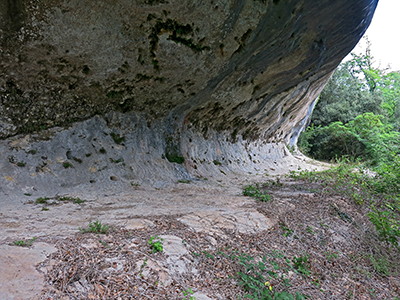
The continuation of the Grand Abri downstream towards the Vézère as a much shallower shelter.
Don Hitchcock 2014
Having noticed a crack that is perpendicular to the bottom of the Grand Abri (Fig. 1,A), Mr Massias has not hesitated to reach the base of this fissure in the ground by opening a huge trench, 29 metres long and about 2 metres wide (Fig. 1, B).
This trench crosses the abri for its whole depth. At the extremity of this trench, it was necessary to dig a pit about two metres deep (Fig. 2 A) and is at the bottom of the excavation that the crack is widest. When we say "widest" it is only in a manner of speaking, for the few people who might be capable of entering the corridor must be skilled gymnasts. The trench abuts the base (Fig. 1, C) of the crack in question, at 250 cm below the original soil.
We abandoned the attempt after two metres!
We confine ourselves, therefore, to giving the information which has been reported to us by those who further explored the area.
This very narrow portion of the passage extends over a length of 10.50 metres and continues in a very tortuous passage, starting at 1 metre wide, then 2.50 m wide, but narrowing to an average width of 1 metre towards the end.
At 20 metres from the entrance is a natural basin (Fig. 2, B) of a metre in diameter. At around 400 metres, which is the greatest distance that we could go, rose a strong spring. (Fig. 2, C).
This spring gives rise to a stream that runs through the end of the gallery for about 100 metres and seeps into the soil (Fig. 2 D) through many cracks, to supply an underground stream or the groundwater. The gallery is therefore a huge conduit for water, above a fault. At intervals one perceives, through cracks in the floor, that the water is approximately 2 metres deep and the water comes into the Abri Gorge d'Enfer, where we find it at a depth of 2.30 m to right and left side of the Abri overhang (fig. 1, E, E'), and it empties into the valley in front of the terrace of the abri.
The floor of the passage, covered with red sand and gravel, is gently sloping. After passing through the first twenty metres, one reaches an elevation of 3 metres, then the floor rises gradually to the far end of the passage.
As to the height of the vaulting, it is impossible to assess during the first twenty metres, but after that point, it is only 1.70 metres, then 1.40 metres in the middle of the passage.
According to information we have from M. Massias, this long passage could not have been inhabited by our ancestors and it was created by the water passing through it.
So we return to the excavations in the Grand Abri.
By examining the walls of the large trench towards the back of the shelter, we can see that the ground has long been crossed by the waters and has formed a kind of immense filter.
We have also noticed several very important prehistoric hearths from which the harvest of flint and bones (Magdalenian industry) was very abundant.
On the left side of the shelter, M, Massias discovered foundations of houses from the Middle Ages (Fig. 1, F), which cover a length of about 14 metres, towards the back of the abri. He found, apart from these foundations, three storage pits a metre deep, one of which contained only fragments of bone, and two others black earth and fragments of pottery from the Middle Ages; beside these foundations, were some prehistoric hearths containing flints and broken bones.
But the most interesting part of the excavation is not in the Grand Abri. Continuing the path to the bottom of the valley and along the outside wall of the rock, we arrive, after having traversed a distance of 80 m at another very small cave, which, owing to its position above the Gorge d'Enfer was called "Oreille d'Enfer" or "Ear of Hell". (Fig. 1, G).
The floor of this cave, which had already been visited by several prehistorians, among others Lartet and Christy, had only been superficially excavated, and only at the entrance.
Mr. Massias removed the earth which filled the cave and was able to penetrate through a corridor of 75cm height, to a depth of 30 metres. This gallery, which we have traveled, is very curious, at approximately 15 metres from the entrance is a fairly large room (Fig 1, H), where you can stand, and then the gallery continues and will probably meet up with the passage at Gorge d'Enfer (Fig. 1, D), in fact, the direction of the wall of the end of the corridor Oreille d'Enfer (currently at 30 meters) agrees perfectly with a meeting of the passage at Gorge d'Enfer, at a point 60 metres from its start. There was a bifurcation in the passage there.
Communication, we believe, will soon be established, the clearance work will be continued very actively.
The walls of the gallery of the Oreille d'Enfer are partly covered with clay and limestone deposits, and we hope to find engravings there one day.
This gallery and especially the terrace which precedes it gave a large quantity of flint and worked bone, which are yet to be described. The first retrievals weigh 300 pounds.
Before concluding this brief communication, we want to draw the particular attention of our colleagues to the tremendous job done with so much science and methodology by M. Albert Massias: this work has required 300 man days and much heavy equipment for the transport and excavation of earth.
One would have hoped that science would more often encounter prehistoric enthusiasts as intelligent and selfless as Mr. Massias and we believe that you will join us in wishing him the praise he deserves.
We add that an agreement was reached between us that the excavations were to continue, and we will inform the Prehistoric Society of France of the fruits of our discoveries.
References
- Burkitt M., 1925: Prehistory: a study of early cultures in Europe and the Mediterranean basin, Cambridge, Cambridge University Press. 1925, Second Edition.
- Collie, G., 1928: The Aurignacians and their culture, Issued January 1928 as Beloit College Bulletin, Vol. XXVI. No 2, printed by the Daily News Publishing Company
- Dawkins W., 1874: Cave Hunting: Researches on the Evidence of Caves Respecting the Early Inhabitants of Europe
- de Sonneville-Bordes, Mme, 1960: Le Paléolithique supérieur en Périgord. Imp. Delmas, Bordeaux, 1960, p. 70/
- Giraux, L., Schleicher, C., 1907: Travaux et fouilles de Gorge d'Enfer. Bulletin de la Société préhistorique française. 1907, tome 4, N. 3. pp. 164-167
- Howard, C., 2002: The Gloss Patination of Flint Artifacts Plains Anthropologist, Vol. 47, No. 182 (August 2002), pp. 283-287 (5 pages), Taylor & Francis, Ltd.
- Jaubert, J., 2008: L'art pariétal gravettien en France : éléments pour un bilan chronologique », Paléo, 20 | 2008, 439-474.
- Lartet E., Christy H. , 1875: Reliquiae Aquitanicae, being contributions to the Archaeology and Palaeontology of Périgord and the adjoining provinces of Southern France, Williams and Norgate, London, 1875.
- Lacorre F., 1960: La Gravette, le Gravettien et le Bayacien, Laval, 1960, 369 pp., 26 fig, 78 planches
- Leroi-Gourhan A., 1984: L'Art des cavernes : Atlas des grottes ornées paléolithiques françaises, Relié – 1 décembre 1984
- Movius H.L. Jr, David N., Bricker H., Clay B., 1968: The analysis of certain major classes of upper palaeolithic tools: Stratigraphy, American School of Prehistoric Research, Peabody Museum, Harvard University, Cambridge, Massachusetts
- Movius H.L. Jr, 1977: Excavation of the abri Pataud, Les Eyzies (Dordogne): Stratigraphy, American School of Prehistoric Research, bull. 31, Peabody Museum, Harvard University, Cambridge, Massachusetts, 167 p., planches h. t.
- Peyrony, D., 1906: Une nouvelle station aurignacienne à Gorge d'Enfer, AFAS, Lyon, 1906
- Peyrony, D., 1906b: Le Périgord préhistorique. Bull. S.H.A.P. 1946, p. 26.
- Peyrony, D., 1932: Les Abris Lartet et du poisson a Gorge-d'Enfer (Dordogne), Masson et Cie., 1932 - 27 pages
- Raoul, D., 1970: Note sur l'Aurignacien de l'abri Pasquet à Gorge-d'Enfer, Les Eyzies (Dordogne). Bulletin de la Société préhistorique française. 1970, tome 67, N. 6. pp. 174-175.
- Sieveking, A., 1979: The Cave Artists, Thames and Hudson
- Tixier, J. (translated by M. Newcomer), 1974: Glossary for the Description of Stone Tools with Special Reference to the Epipalaeolithic of the Maghreb, Newsletter of Lithic Technology: Special Publication Number 1 - December 1974
- Wesley W, 1974: Pièces Esquillées in the Southeast. Florida Anthropologist, vol. 27, no. 4, December 1974, p. 161.
Back to Don's Maps
 Back to Archaeological Sites
Back to Archaeological Sites
